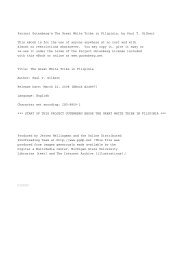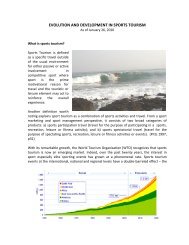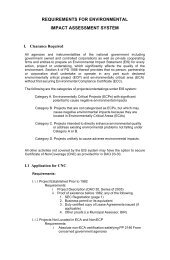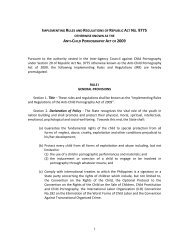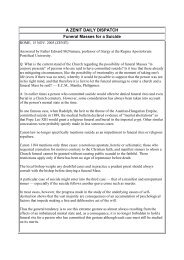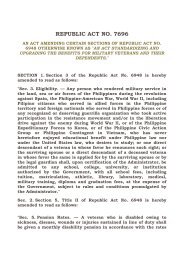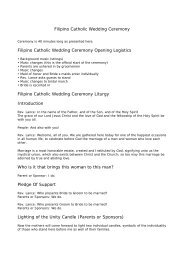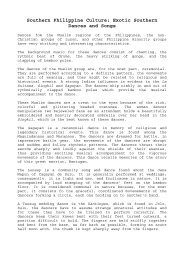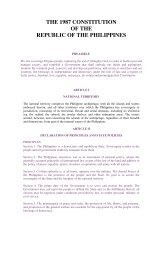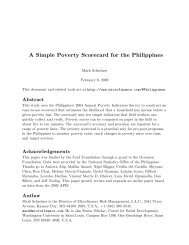The Ingenious Filipino Boat - Philippine Culture: Overview Culture
The Ingenious Filipino Boat - Philippine Culture: Overview Culture
The Ingenious Filipino Boat - Philippine Culture: Overview Culture
You also want an ePaper? Increase the reach of your titles
YUMPU automatically turns print PDFs into web optimized ePapers that Google loves.
<strong>The</strong> <strong>Ingenious</strong> <strong>Filipino</strong> <strong>Boat</strong><br />
By FR. Gabriel S. Casal, Eusebio Z. Dizon, Wilfredo P. Ronquillio, Cecilio G. Salcedo<br />
Kasaysayan Vol. 2: <strong>The</strong> Earliest <strong>Filipino</strong>s<br />
kill and creativity have seen the people of the <strong>Philippine</strong> archipelago through many difficult situations.<br />
About a thousand years ago, these were the very same talents they used to succeed in a flourishing<br />
maritime trade with other Asian countries. <strong>The</strong>ir close affinity with the waters around them help improve<br />
their seamanship and boatbuilding skill, placing them on equal footing with their Asian neighbors.<br />
This also earned them due notice from season European and Asian voyagers, as well as their chroniclers.<br />
Actual maritime trade records dating to as early as the 13 th century have been found. Chao Ju-<br />
Kua’s work, Reports on the South Sea Barbarians, completed in 1225, gave a detailed account of maritime<br />
activities in the <strong>Philippine</strong>s during those times. Wang Ta-Yuan, another Chinese chronicler, made similar<br />
reports in 1349. the most detailed description, however, may be found in the accounts from Francisco<br />
Alcina’s History of the Visayan Islands of 1668.<br />
Early boats of the <strong>Philippine</strong>s<br />
<strong>The</strong> discovery of the balangay boats in Buturan, Agusan<br />
del Norte in the late 1970s served as further testimony to<br />
the ingenuity of the early <strong>Filipino</strong>.<br />
What were the balangays? <strong>The</strong>se were the<br />
first wooden watercraft excavated in Southeast Asia. When<br />
first announced to the media in 1977, the find was<br />
described by the National Museum of the <strong>Philippine</strong>s using<br />
Antonio Pigafetta’s early 16 th -century Italian spelling<br />
“balanghai” for “barangay”, a term which has been adopted<br />
by the <strong>Philippine</strong> government as a name for the smallest of<br />
political units. This was perhaps in deference to the unique<br />
brand of unity evident among the builders of these boats.<br />
<strong>The</strong>re are nine existing balangays, three of<br />
which have been systematically excavated by National<br />
Museum archaeologist, with others still waterlogged in<br />
specific sites in Butuan Ciy. Keeping the remaining boats in<br />
situ has proven to be the best way to preserve them, while<br />
they await eventual excavation.<br />
<strong>The</strong> first boat, now preserved and displayed in a site museum in Libertad, Butuan City, had<br />
a carbon-14 date of 320, while the second boat, which has been transferred to the Maritime Hall of the<br />
National Museum in Manila, was dated to 1250. <strong>The</strong> third boat remains in a conservation vat the at the<br />
Butuan Regional Museum, undergoing preservative measures.<br />
<strong>The</strong> balangay was basically a plank boat put together by joining the carved-out planks edge<br />
to edge, using pins or dowels. <strong>The</strong> planks, which were made from a hardwood called doongon in the<br />
<strong>Philippine</strong>s (Heritiera littoralis), were fastened together every 12 centimeters long, which were driven into<br />
holes on the edge of each plank. On the inner side of the boat the planks were provided, at regular<br />
intervals, with raised rectangular lugs, carved from the same plank, through which holes were bored<br />
diagonally from the sides to the surface.
Rib-like structures made of lengths of wood were then lashed against these lughs to proved<br />
a flexible bulkhead, to reinforce and literally sew the boat together. Cordage knows as cabo negro (Arenga<br />
pinnata) was used for the purpose. <strong>The</strong> hull, measuring about 15 meters long and 4 meters wide, was<br />
ordinally semicircular in cross-section and with no marked keel. Provided with huge outriggers, the boat<br />
was propelled either by a sail or by paddling. <strong>The</strong> boats were finely manufactured without any blueprints,<br />
using a technique still employed by the boatmakers of Sibutu Island in the southern <strong>Philippine</strong>s.<br />
<strong>The</strong>re is no basic difference in the technology of boatbuilding seen in the first two dated<br />
balangays, suggesting the stability of this construction technique over the last 900 years. <strong>The</strong> third boat,<br />
which was recovered in 1986, likewise exhibits the same mode of construction. This is a style of<br />
boatbuilding which was once popular from Scandinavia to the South Pacific, from the 3 rd century B.C. to<br />
the present time in a few remote islands.<br />
<strong>The</strong> master shipwright selects his tree<br />
Noted historian William Henry Scott elaborated on<br />
Francisco Alcina’s account of boatbuilding and<br />
seamanship in the <strong>Philippine</strong>s by describing the basic<br />
methods of constructing plank-built boats in detail.<br />
A master shipwright was called a panday a<br />
title he shared with other craftsmen such as iron-workers<br />
and goldsmiths. <strong>The</strong> panday went to the forest with his ax,<br />
a straight adz called a dallag, a curved one called a<br />
bintong and a spoon-bit about 20 centimeters long with a<br />
wooden handle called a lakob. He then selected his tree.<br />
Lawaan was preferred because it is a strong hardwood<br />
which grows large enough for a canoe 120 centimeters<br />
wide to be hewn from a single trunk.<br />
In the <strong>Philippine</strong>s, tropical trees generally have a decayed center – the Visayans call it<br />
bokag – caused by a fungus infection which enters through the root system and eventually rots and splits<br />
the trunk. <strong>The</strong> center therefore had no rejected, though the two halves could be solid timber if the tree was<br />
carefully selected. <strong>The</strong> other 4 or 5 centimeters were also rejected as being aramay – soft spongy or<br />
fibrous – and thus vulnerable to insects. Since the tree was too large to be moved conveniently on the<br />
ground, it was felled in the exact position the panday wanted. He then marked out straight lines along it<br />
with a cord called a kutur, and set to work.<br />
A boat emerges from the wood<br />
<strong>The</strong> entire outer from of the hull was carved into shape before hollowing out the inside – sharp at the<br />
bottom like a keel, pointed at both ends, and V-shaped, with sides no thicker than a board. <strong>The</strong> adz was<br />
sometimes used like a chisel, hammered with a mallet called a pakang. To check the progress of the<br />
thinning process as he worked, the panday frequently bored holes through the sides with the lakob, holes<br />
which would later be plugged watertight. <strong>The</strong>n the interior was hollowed out, leaving the necessary<br />
projections or tambukos for the ribs or agara. A good panday could make such a hull, 9 to 10 meters long<br />
and 1-1/2 meters wide, working by himself, in eight to ten days.<br />
Such a boat carved out of a single piece of wood was called a baroto, what the Tagalogs<br />
called a banca. Some were small enough for one man to lift. It was impractical, however, to build larger<br />
vessels on dugout canoe bases, so those above 10 meters in length were constructed on square keels as<br />
edge-pegged, plank-built boats. This was the size and style knows by the name of barangay or balangay,<br />
although the Tagalog version was sewed or laced, not edge-pegged.
Putting the pieces together<br />
<strong>The</strong> flat or round-bottomed Butuan boats,<br />
lacking either a real keel or a canoe base, did<br />
not fit any of these categories, though they<br />
were within the balangay size range. In<br />
addition, they displayed another unique<br />
feature: the center plank, which served as a<br />
keel, had two or three thin tambukos parallel<br />
to one another instead of the broad ones<br />
appearing on the adjoining planks, though<br />
these were of the same length and thickness.<br />
In the absence of other known examples, a definite function has not yet been assigned to<br />
this special feature. It was possible that the plank-shaped timbers standing on edge may have been lashed<br />
to these tambukos to serve as a kind of interior keel, though these would have been cut out to fit the<br />
transverse ribs.<br />
<strong>The</strong> shell was then left to season for a moth or two, carefully elevated to avoid infestation by<br />
termites. When it was sufficiently dried out, the planks were removed one by one and all the broken pegs<br />
removed and replaced. <strong>The</strong>n the shell was reassembled in three distinct stages called sugi (matching), osos<br />
(tightening), and pamota (closing).<br />
Sugi was carried out with the use of a little wooden tool for making lines. It had sharp iron<br />
point 2 to 3 millimeters above a projecting tongue or lip, and was small enough to fit in the palm of the<br />
hand. After the planks had been put together again but not hammered tight, a carpenter with a strong grip<br />
placed the little lip of the upper edge of a board, with the point biting into the side of the board. <strong>The</strong>n he ran<br />
it from stem to stern, both inside and out, applying enough pressure to incise a sharp line along the upper<br />
board near its lower edge.<br />
This mark naturally reproduced whatever irregularities the original adzing may have left on<br />
the lower board.



